A gummy smile, or excessive gingival display, occurs when more than two millimetres of gum tissue are visible above the teeth and below the lips, affecting less than 30% of the population and is more commonly found in women. A gummy smile or small teeth big gums is inherited and is linked to irregular tooth formation, hyperactive upper lip muscles, a short upper lip, or an overgrown upper jaw. Genetic influences, such as hereditary gingival fibromatosis and hormonal changes during pregnancy or puberty, contribute to a gummy smile. Inadequate dental hygiene, altered tooth eruption, and certain medications, including immunosuppressants and anticonvulsants, result in gum enlargement. Corrective therapy is sought by some people for cosmetic purposes, even if it is not a medical concern.
A gummy smile treatment encompasses Orthodontic Treatment, Veneers or Crowns, Crown-Lengthening Surgery, Lip Surgery, Laser Gum Contouring, and Gingivectomy. Orthodontic treatment employs braces to realign teeth and jaws, mitigating excessive gingival display. Veneers or crowns enhance dental aesthetics by elongating the appearance of teeth, rendering them more proportionate. Crown-lengthening surgery excises surplus gum tissue and bone to unveil a greater portion of the tooth. Lip surgery is a known surgery for gummy smile that repositions the upper lip to diminish gum visibility, while laser gum contouring meticulously sculpts excess gingival tissue. Gingivectomy surgically excises gum tissue to improve oral hygiene and aesthetic appeal.
The advantages of gummy smile treatment include creating a balanced, even smile that improves facial symmetry and overall appearance, resulting in a more harmonised appearance. Exposing a greater portion of the teeth's surface area produces a more proportionate and lengthier appearance, contributing to a natural and attractive smile. The smile's aesthetics are improved by reducing gum prominence and ensuring appropriate proportions by enhancing the tooth-to-gum ratio. Eliminating uneven gum lines results in a more uniform, smoother appearance, enhancing the smile's symmetry. A more elongated and visually appealing smile increases self-assurance, facilitates more effective social interactions, and promotes oral health by reducing the risk of periodontal disease and simplifying dental hygiene.
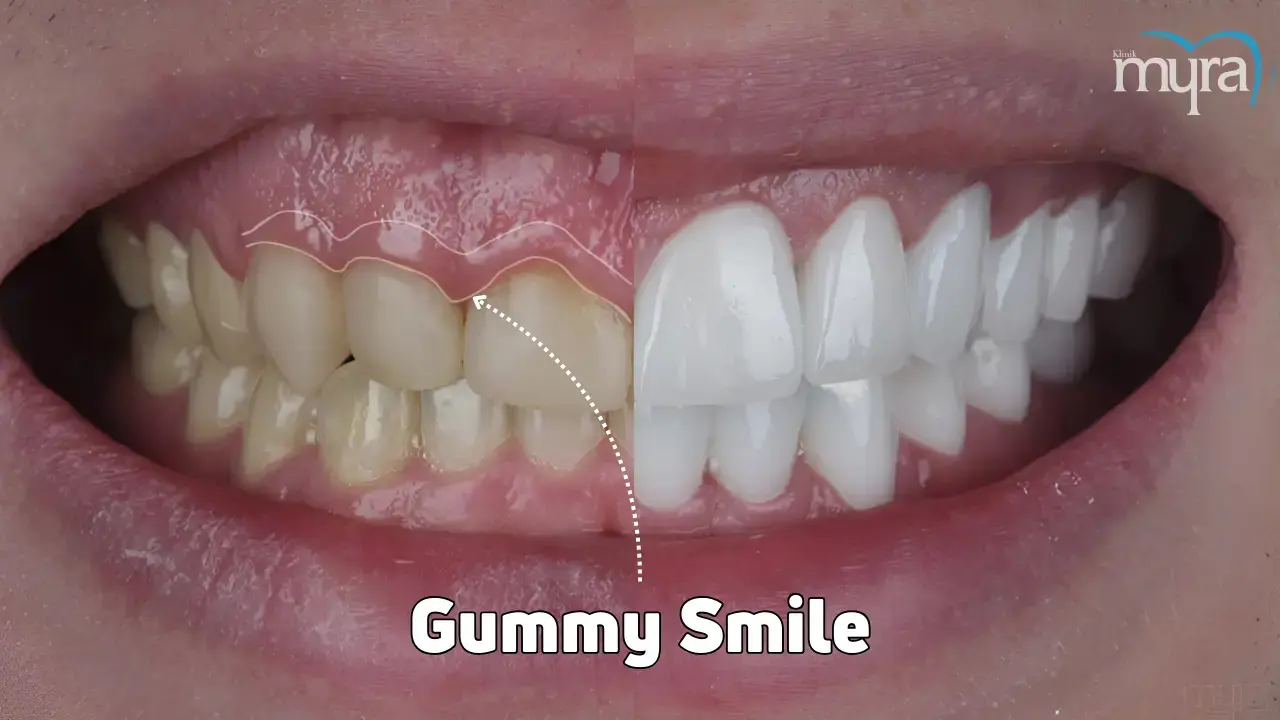
What is a gummy smile?
A gummy smile, known as "excessive gingival display," is characterised by more gum tissue revealed than is usual above the teeth. A "gummy" smile is one in which more than two millimetres of gums are visible above the teeth and the lips, directly answering the question, “What is gummy smile?” Gummy smiles are a type of dental problem that is more common in women and affect less than 30% of the population, although they are not cause for alarm.
Gummy smiles are inherited and do not signal any underlying medical conditions. Some people with a gummy smile seek corrective therapy if they are uncomfortable with even a single millimetre of gum visible, according to subjective aesthetic preferences. Personal tastes prompt patients to investigate solutions such as braces to lessen the appearance of a gummy smile.
Why Some People have Gummy Smile?
Some people have a gummy smile as it is associated with an irregular tooth formation, hyperactive upper lip muscles, a short upper lip, or an overgrown upper jaw. An abnormal eruption of teeth is a prevalent cause, in which the teeth fail to emerge properly from the gums, resulting in a substantial portion of the tooth being concealed by periodontal tissue. The hyperactivity of the upper lip muscles is another contributing factor, as it causes the lip to rise higher than usual when smiling, exposing more gum tissue. The gums are pushed downward, resulting in a gummy appearance due to excessive growth of the upper mandible bone, which is referred to as vertical maxillary excess.
A gummy smile is hereditary. Many people with a gummy smile inherited their condition from their parents, who have a gummy smile. Parents with a gummy smile predispose their children to attain the condition as it results in a pattern of atypical growth, such as a short upper lip, small teeth, or an overgrown upper jaw.
What Causes a Gummy Smile?
The causes of a gummy smile are listed below.
- Anatomy and Genetics: A gummy smile is considerably influenced by genetics, characterised by a large jaw, small teeth, and a short upper lip, which directly responds to the question, “What causes a gummy smile?” Hereditary gingival fibromatosis (HGF), a rare condition, results in severe gum overgrowth, which causes speech concerns. Gum enlargement is induced or exacerbated by hormonal changes during pregnancy or puberty and blood disorders such as leukaemia.
- Inadequate Dental Hygiene: A gummy smile results from plaque deposition, which inflames and enlarges the gums due to insufficient dental hygiene. Conventional orthodontics complicates oral hygiene, which leads to gum inflammation and the accumulation of bacteria. A cycle of poor hygiene and gum enlargement is frequently initiated by patients who refrain from brushing and flossing due to the pain they experience from gum issues.
- Tooth Eruption Modified: Altered tooth eruption (ATE) occurs when teeth fail to completely emerge from the gums, resulting in a partial covering. The condition results in a gummy smile, which is not a significant health concern but impacts the smile's aesthetics. It frequently entails the incomplete eruption of specific teeth, such as permanent molars, around six.
- Adverse Effects of Medication: Gum enlargement is a potential adverse effect of certain medications, such as immunosuppressants such as Cyclosporin A, prescribed to transplant patients. Phenytoin, a type of anticonvulsant, and heart disease medications such as Nifedipine, Verapamil, and Diltiazem induce gingival overgrowth. These medications unintentionally induce gingival enlargement, affecting the smile's appearance.
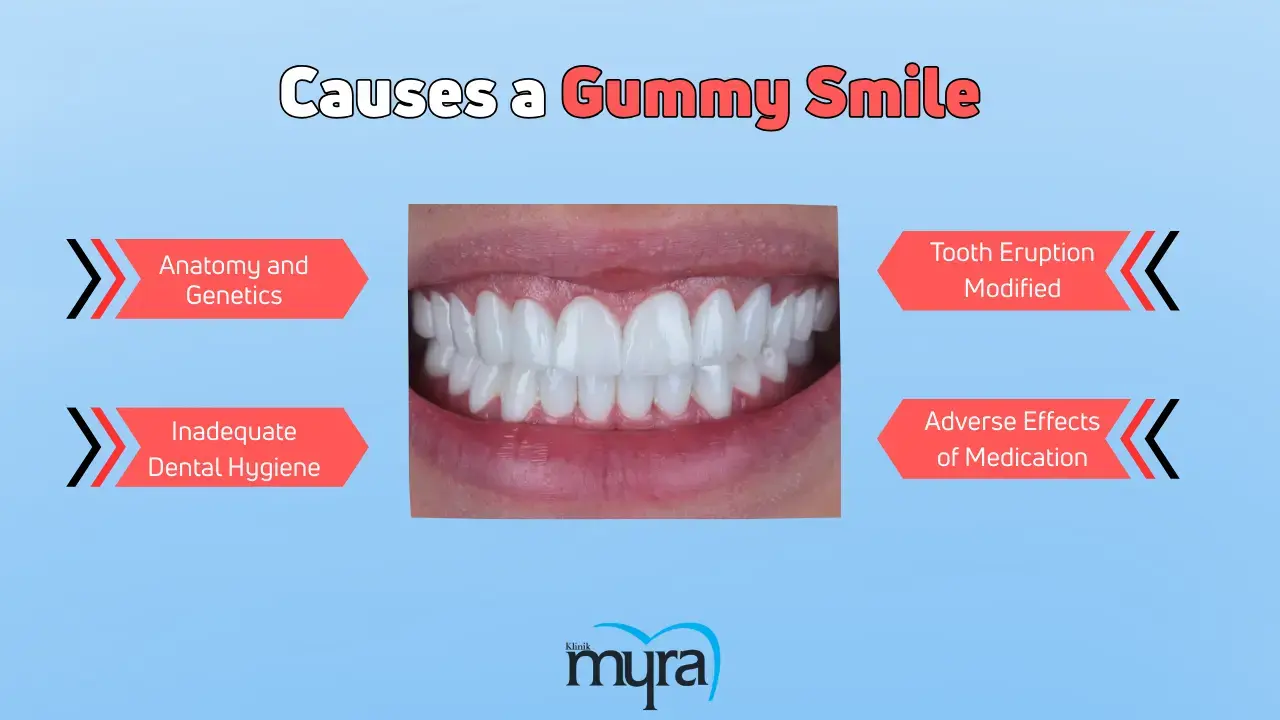
How to get rid of a gummy smile?
The ways to get rid of a gummy smile are listed below.
- Orthodontic Treatment: Orthodontic treatment involves correcting misaligned teeth and jaws to improve oral health, functionality, and gummy smile. It often includes braces, aligners, and other dental appliances.
- Initial Consultation and Diagnosis. The orthodontist conducts a comprehensive examination, encompassing dental history, clinical evaluation, radiographs, and dental impressions.
- Preparation and Appliances Placement. Professional prophylaxis removes plaque and calculus deposits from teeth. Orthodontic treatment appliances, such as braces or aligners, are carefully applied according to the treatment plan.
- Regular Adjustments and Monitoring. Patients have regular sessions for precise modifications to their orthodontic appliances. Progress is meticulously tracked, and appropriate changes are implemented.
- Maintaining Oral Hygiene. Patients are given extensive guidance on advanced oral hygiene procedures such as diligent brushing, flossing, and caring for orthodontic appliances. Regular dental examinations are required to avoid caries and periodontal problems.
- Completion and Retention. Orthodontic equipment is gently removed once the teeth have been aligned properly. Retainers are used to maintain corrected dental positions and avoid orthodontic relapse.
- Veneers: Veneers are thin, custom-designed shells applied to the teeth' front surfaces. Veneers are manufactured from tooth-coloured materials, such as porcelain or composite resin, and are used to treat gummy smiles. They are designed to visually improve the appearance of teeth by concealing excessive gingival tissue, generating the illusion of a balanced and proportionate smile.
- Initial Consultation and Diagnosis. A comprehensive examination that includes the dental history and radiographs to assess the gum-to-tooth ratio is conducted at the initial session.
- Tooth Preparation and Gum Contouring. Gum contouring reduces excessive gum tissue and reshapes the gum line. A small quantity of enamel is removed from the dental surfaces to accommodate the veneers.
- Temporary Veneers and Impressions. Precise moulds are performed for the custom veneers by taking impressions of the prepared teeth. Temporary veneers are installed to safeguard the teeth and enhance their appearance, while permanent veneers are manufactured.
- Veneers Manufacturing. The impressions are sent to a dental laboratory, where they are used to create custom veneers from high-quality materials such as composite resin or porcelain. Guarantee that the veneers are consistent with the intended colour, shape, and size.
- Final Adjustments and Veneers Bonding. Permanent veneers are tested for fit and aesthetics after removing the temporary veneers. Bond the veneers to the teeth using a robust dental adhesive, make any required modifications, and polish them to achieve a natural, lustrous appearance.
- Crowns: Crowns for gummy smile treatment are custom-made caps covering a tooth's entire visible portion, lengthening its appearance and reducing gum prominence. Crowns produce a more balanced and visually beautiful grin since they are made of strong materials like porcelain or ceramic.
- Begin with Consultation and Diagnosis. A comprehensive examination contains a detailed analysis of the gum-to-tooth ratio, dental history, and X-rays. Formulate a treatment plan tailored to the patient, emphasising installing a crown to compensate for the gummy smile.
- Gum Contouring and Tooth Preparation. A gum contouring is accomplished to reshape the gum line, reducing excessive gum tissue. Reshape the tooth by removing a portion of its structure to create space for the crown.
- Impressions and Temporary Crown Placement. An accurate mould is created for the custom crown by taking impressions of the prepared tooth. Temporary crowns must be positioned to protect the tooth and maintain its appearance and functionality while the permanent crown is being made.
- Crown Fabrication. Send the impressions to a dental laboratory where the custom crowns are crafted from high-quality materials like porcelain or ceramic. Ensure the crown matches the desired colour, shape, and size for a natural look.
- Crown Placement and Final Adjustments. Test the permanent crown for fit and aesthetics after removing the temporary crown. Adhere the crown to the prepared tooth using a strong dental adhesive, make any required modifications, and polish the crown to achieve a natural, flawless appearance.
- Crown-Lengthening Surgery: Crown-lengthening surgery is a dental operation that exposes more of a tooth's structure by removing extra gum tissue and bone, usually for cosmetic or restorative reasons. Crown-lengthening surgery makes teeth appear longer and allows the gums to settle correctly, improving the smile's overall appearance.
- Initial Consultation is Conducted. A thorough examination, including X-rays, assesses dental and gum health. A personalised treatment plan is developed to address specific needs and goals.
- Preparing for Surgery. Local anaesthesia is administered to numb the area and ensure comfort during the procedure. The surgical area is cleaned and ready for the operation.
- Gum Tissue Removal is Conducted. Small incisions separate the gums from the teeth, exposing the underlying bone and tooth structure. Excess gum tissue is carefully removed to achieve the desired lengthening.
- Bone Reshaping is Done if Necessary. Sometimes, a little portion of the bone around the tooth's root is removed or altered to allow enough exposure to the tooth structure. It helps in creating a stable foundation for the crown or other restorations.
- Suturing and Healing. The gum tissue is repositioned and sutured to promote proper healing. A protective dressing is placed over the surgical site to aid healing.
- Lip Surgery: Lip surgery is a treatment performed to fix a gummy smile caused by a short or hyperactive upper lip, which exposes more gum tissue when smiling. Small incisions are made inside the upper lip to remove a strip of tissue, which is then sutured to a lower position to limit gum exposure. Lip surgery is less invasive than jaw surgery and efficiently reduces the gummy appearance of the smile.
- Thorough Assessments are Conducted. A comprehensive examination, including detailed dental history, clinical evaluation, and diagnostic photographs, is conducted to assess the severity of the gummy smile. A meticulously tailored treatment plan addresses the patient's aesthetic and functional requirements.
- Surgery Preparation. Local anaesthesia is meticulously administered to anaesthetise the surgical site, ensuring patient comfort throughout the procedure. The area is then aseptically cleansed and prepared for surgical intervention.
- Incision and Tissue Excision. Precise incisions are made on the mucosal surface of the upper lip. Redundant mucosal and connective tissue is carefully excised to shorten the vertical dimension of the lip and reduce excessive gingival exposure.
- Lip Repositioning. The upper lip is strategically repositioned and secured closer to the teeth to conceal a greater portion of the gingiva. The modified lip position is then meticulously sutured to ensure stability and optimal aesthetic outcomes.
- Suturing and Recovery. The surgical incisions are meticulously closed with sutures, which are absorbable or necessitate removal during a subsequent follow-up appointment. A protective dressing facilitates the healing process and prevents complications.
- Laser Gum Contouring: Laser gum contouring is a sophisticated dental procedure that meticulously reshapes and excises superfluous gum tissue, improving the smile's aesthetics using a laser. Laser gum contouring is effective for patients with a gummy smile, as it precisely removes superfluous gum to reveal a more significant portion of the teeth, resulting in a more visually appealing and harmonious appearance.
- Local Anesthesia Administration and Sterile Field Preparation. Local anaesthesia is administered to the patient after a thorough assessment and diagnosis. The surgical site is then cleaned and sterilised to prevent infection exposure.
- Laser Gum Contouring is Performed. A specialised dental laser precisely removes and reshapes excess gum tissue. The laser cauterises as it cuts, minimising bleeding and reducing the risk of infection.
- Immediate Post-Procedure Care. The contoured gums are evaluated for symmetry and the intended aesthetic result. Immediately following the procedure, the patient is provided with instructions for cleansing the mouth with an antiseptic mouthwash and addressing any initial discomfort.
- Gingivectomy: A gingivectomy is a dental surgical procedure that entails the removal of gum tissue (gingiva) to address gum disease or enhance the appearance of the gums. A gingivectomy is implemented to eradicate diseased gum tissue and decrease the pocket depth between the teeth and between the teeth and gums, which serve as a breeding ground for bacteria.
- Preparation for the Procedure. Local anaesthesia is injected to numb the area and ensure comfort throughout the procedure. The dentist cleans the area thoroughly to create a sterile environment.
- Removing Excess Gum Tissue. The dentist removes excess gum tissue using specialised tools or dental lasers. The procedure exposes more teeth, creating a healthier and more aesthetically pleasing gum line.
- Shaping the Gum Line. The dentist sculpts the remaining gum tissue to ensure a natural and attractive appearance. The step is for functional and cosmetic reasons, ensuring the gums heal correctly and look good.
- Post-Operative Care and Follow-up. The patient receives comprehensive instructions on how to take care of their gums following the treatment, along with guidance on diet, pain management, and oral cleanliness. Follow-up appointments are scheduled to monitor the healing process and ensure the best possible outcome.
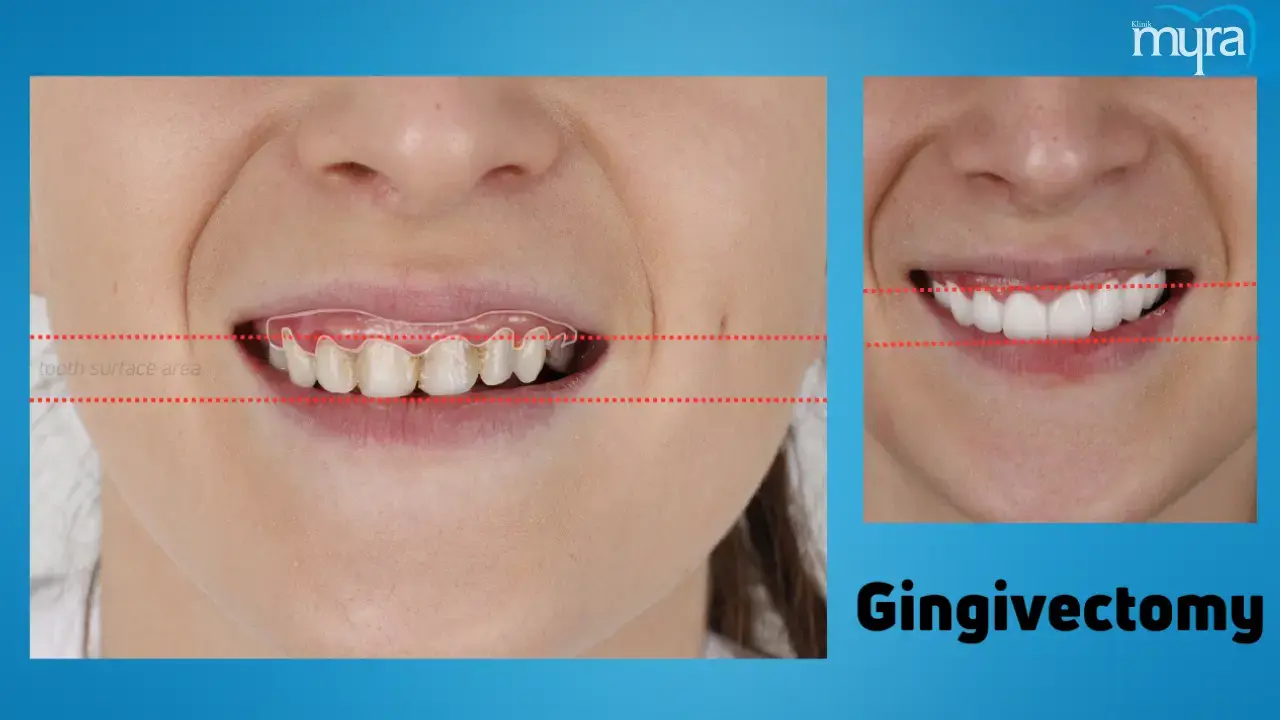
The various procedures for addressing a gummy smile offer several benefits, including long-term solutions such as orthodontic treatment and certain surgeries that improve function and appearance. Enhanced aesthetics are a significant advantage, as treatments like veneers, crowns, and laser gum contouring create a more harmonious and visually appealing smile. The procedures improve oral health by addressing underlying dental issues, reducing the risk of decay, and promoting better hygiene. Durable and customisable options like veneers and crowns allow for tailored results that blend seamlessly with natural teeth. Laser gum contouring and lip surgery offer quick recovery times and minimal invasiveness, making them attractive options for patients seeking efficient and effective treatments.
High costs are a common drawback, with treatments ranging from a few hundred to several thousand dollars. The procedures involve potential discomfort and pain during and after the treatment, which deters patients. Lengthy treatment and recovery times are associated with certain options, such as orthodontic treatment and crown-lengthening surgery, requiring a significant time commitment. There are infections, scarring, or asymmetry risks, particularly with surgical interventions. Regular maintenance and follow-up care are necessary for some treatments to ensure long-term success. The invasive nature of procedures, like gingivectomy and crown-lengthening surgery, is off-putting for patients seeking less intensive solutions.
Who needs Gummy Smile Treatment?
The people who need gummy smile treatment are patients with high gums, small teeth with big gums, a short upper lip, hyperactive lip muscles, altered tooth eruption, poor dental hygiene, and taking certain medications. An imbalance between the gums and teeth is exhibited by patients with high gums, who exhibit an excessive quantity of gum tissue above their upper teeth. People with tiny teeth and prominent gums exhibit teeth that are smaller than the visible gum tissue, resulting in a less aesthetically pleasing smile. Hyperactive lip muscles or a short upper lip exhibit an exaggerated gum display when beaming, rendering them ideal candidates for treatment.
People who have altered tooth eruption, in which their teeth do not wholly emerge from the gums, frequently pursue treatment to rectify the gummy appearance of their smile. Patients who maintain inadequate dental hygiene develop inflamed and enlarged gums due to plaque accumulation, which requires treatment to reestablish a harmonious smile. People taking specific medications, such as immunosuppressants, anticonvulsants, or heart disease medications, experience gingival enlargement as an adverse effect, rendering them suitable candidates for gummy smile treatment.
What are the risk of Gummy Smile?
The risk of gummy smile is listed below.
- Poor Physical Appearance: A gummy smile considerably impacts a person's smile aesthetics, leading to self-consciousness and decreased confidence. Excessive gum tissue overshadows teeth, resulting in an unbalanced and unappealing appearance.
- Oral Health Issues: Excess gum tissue makes it difficult to maintain good oral hygiene, increasing the risk of plaque development and periodontitis. Inflamed gums are caused by a rise in inadequate hygiene and gummy appearance, resulting in a cycle of oral health difficulties.
- Speech Impediments: A gummy smile gets in the way of clear speaking, making it hard to pronounce certain consonants. Excess gum tissue causes lip and tooth alignment issues during speech.
- Functional Discomfort: Patients with a gummy smile feel discomfort while biting and chewing due to the improper gum-to-teeth ratio. Improper food breakdown causes digestive difficulties and poor mastication.
What are the Different Types of Gummy Smiles?
The different types of gummy smiles are listed below.
- Anterior Gummy Smiles: Anterior gummy smiles refer to the excessive display of gum tissue in the front teeth region when a patient smiles. It is a gummy smile often caused by disorders like overactive upper lip muscles or inappropriate anterior tooth eruption. Patients with a gummy smile must search for "types of gummy smile with pictures" to see if they have anterior gummy smiles to have prior knowledge before consulting a dentist.
- Posterior Gummy Smiles: The posterior gummy smile is characterised by a prominent display of gums in the back teeth region. The condition is less common among types of gummy smiles and is usually caused by abnormalities in the gum line or excessive gum tissue growth in the back area.
- Mixed Gummy Smile: An excessive gum exhibit that affects both the front and back teeth is the defining feature of mixed gummy smiles. The condition's cause is a combination of factors affecting the pharynx's anterior and posterior regions.
- Asymmetric Gummy Smiles: Asymmetric gummy smiles are characterised by an asymmetrical gum display in which one side of the smile reveals a more significant amount of gum tissue than the other. Variations in tooth eruption or differential development of gum tissue on either side of the mouth cause the asymmetry.
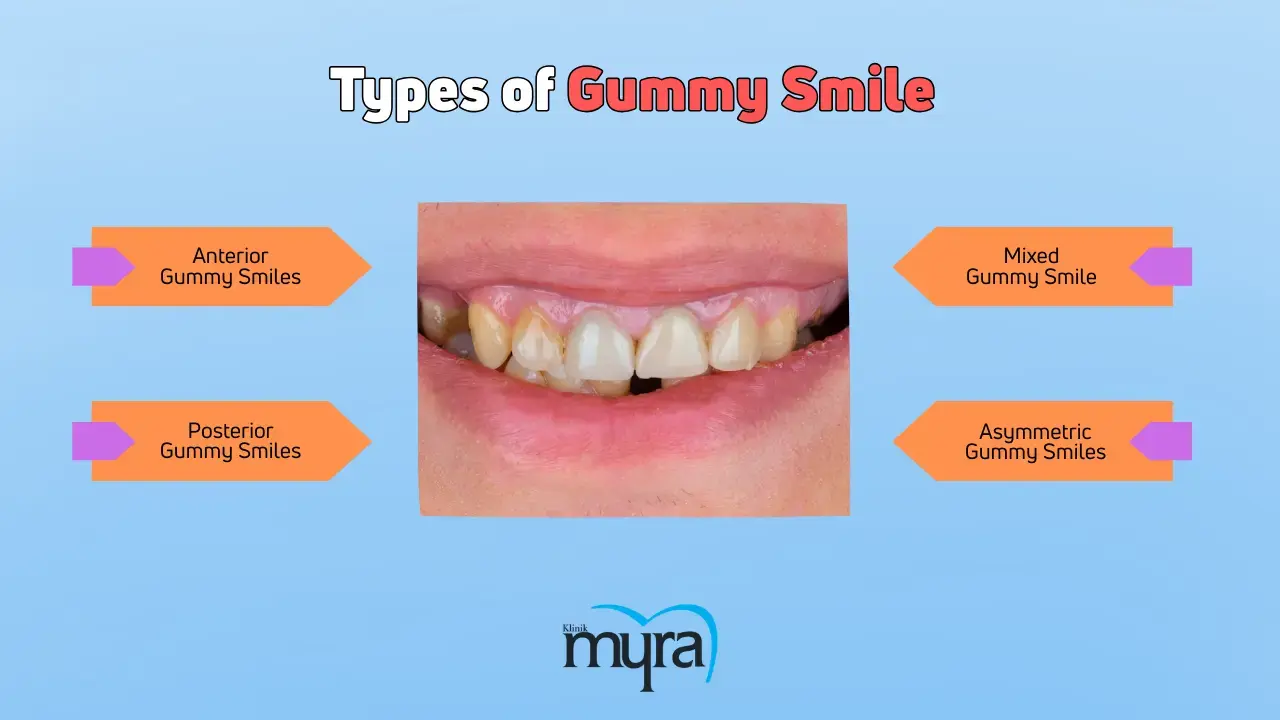
Why you should Consider Gummy smile Correction?
You should consider a gummy smile correction to enhance the smile's physical appearance, decrease the risk for gum diseases, and reduce speech impediments. Correcting a gummy smile results in a more balanced and appealing smile, enhancing self-confidence and social interactions by substantially improving facial aesthetics. The risk of plaque accumulation and periodontal diseases is elevated by excessive gum tissue, which makes it difficult to maintain oral hygiene. Reducing gum exposure improves oral health management.
Enhancing the smile's appearance through correction procedures mitigates speech impediments that occasionally accompany excessive gingival display. Procedures like gum contouring, gum reduction, orthodontics, or surgery treat esthetic issues and enhance the functional features of the oral cavity, which supports general dental health. Considering a gummy smile correction results in aesthetic and health benefits, improving one's quality of life.
Can You Surgically Fix a Gummy Smile?
Yes, you can surgically fix a gummy smile. Several surgical options are available to rectify a gummy smile, contingent on the underlying cause. Crown-lengthening surgery entails the removal of surplus gum tissue and bone to reveal more of the tooth structure, thereby diminishing the gum display. Lip repositioning surgery targets hyperactive upper lip muscles by modifying the lip's position to restrict upward movement when smiling, thereby covering more gum tissue. Orthognathic surgery is employed to realign the jaw when it is excessively prominent, resulting in a more harmonious and appealing smile. These procedures significantly enhance the smile's appearance and functionality, addressing a gummy smile's cosmetic and health concerns.
Is Gum Contouring the Most Common Gummy Smile Treatment?
Yes, gum contouring is the most common gummy smile treatment. Gum contouring is popular because it is minimally invasive and removes extra gum tissue, improving the smile's appearance. The procedure employs lasers and surgical tools to restructure the gum line accurately, resulting in a more balanced and aesthetically pleasing smile. A surgery for gummy smile, such as gum contouring, has a shorter recovery time and usually causes less discomfort than intrusive surgical alternatives such as orthognathic surgery. The surgery is performed in just one visit, making it a practical alternative for many patients wishing to fix a gummy smile.
What are the Benefits of Gummy Smile Treatment?
The benefits of the gummy smile treatment are listed below.
- Balanced, Even Smile: Creating a balanced, even smile improves the appearance of the face, making the smile more symmetrical and appealing. The development resulted in a more harmonised facial look.
- Greater Surface Area of Teeth: Exposing a larger surface area of the teeth makes them look longer and more proportionate. Correcting the surface area helps to create a more natural and attractive smile.
- Improved Tooth-to-Gum Ratio: Improving the tooth-to-gum ratio guarantees that the teeth and gums are in proper proportions. The equilibrium improves the smile's appearance and lessens the gums' prominence.
- Eliminates Uneven Gum Lines: Eliminating an uneven gum line results in a smoother, more uniform look of the gums. The adjustment considerably improves the symmetry and appearance of your smile.
- Wider, More Appealing Smile: A broader, more appealing smile enhances the appearance of the teeth. The augmentation makes the smile look more appealing and inviting.
- Enhanced Self-Confidence: A more appealing smile improves social interactions and self-esteem; increasing self-confidence is a significant advantage. People feel more at ease and confident when their smile complements their intended look.
- Promotes Better Oral Health: Another significant advantage is that removing extra gum tissue makes dental hygiene procedures easier. The change reduces the risk of gum disease and other oral health complications.
How should you Prepare for Gummy Smile Treatment?
The ways to prepare for gummy smile treatment are listed below.
- Consult a specialist: Consult a dental professional who assesses the patient’s situation and provides the best treatment alternatives. It ensures that the therapy is personalised to the specific needs and increases the likelihood of success.
- Maintain Optimal Oral Hygiene: Brush and floss frequently, and consider getting a professional cleaning. A healthy mouth is critical to lowering the risk of infection and problems during and after the surgery.
- Understand the Treatment Plan: Discuss the procedure, potential risks, and expected outcomes with the dentist. Knowing what to expect helps the patient feel less anxious and prepare emotionally and physically for the surgery.
- Adjust Medications as Necessary: Discuss the current medicines with the dentist; some must be modified or halted before treatment. It guarantees that no medicine disrupts the therapy or healing process.
- Plan the Recovery Time: Plan the schedule to give enough time for healing following the surgery. It includes taking time off work as needed and planning for any food restrictions or physical activity constraints throughout the recuperation period.
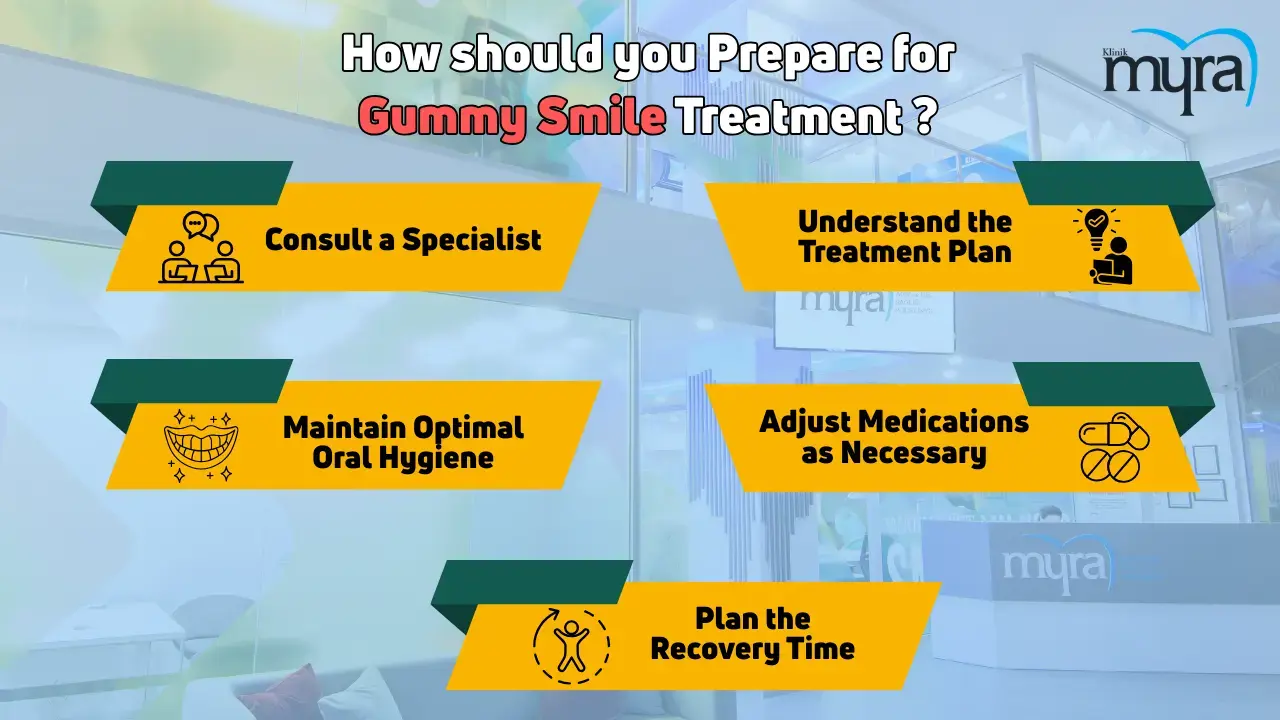
Can dentures be used to treat Gummy Smile?
Yes, dentures can be used to treat a gummy smile. Custom-made dentures are designed to cover a significant portion of the gum tissue, reducing the visible gum area when smiling. An even and visually appealing smile is achieved by modifying the dentures' size, shape, and fit so that the teeth stand out more and the gums are less visible. Dentures effectively address the cosmetic concerns of a gummy smile by altering the visible gum-to-teeth ratio, providing a tailored solution that enhances the overall dental appearance.
Is the Gummy Smile Correction worth it?
Yes, gummy smile correction is worth it. A gummy smile has the potential to significantly improve the overall appearance of the smile and increase confidence. The treatment positively impacts the self-esteem and social interactions of many patients who endure it, as they report feeling more comfortable and satisfied with their smiles. The procedure corrects the imbalance between teeth and gums, resulting in a more aesthetically appealing and harmonious smile. A gummy smile correction decreases the risk of gum diseases and other oral problems caused by poor oral hygiene.
How Can "Turkey Teeth" Enhance a Gummy Smile?
Yes, turkey teeth can enhance a gummy smile. “Turkey teeth” is a set of procedures conducted in Turkey, including dental veneers or crowns, which are renowned for being affordable. A more balanced and aesthetically appealing smile is achieved through these treatments, which significantly enhance the appearance of a gummy smile. “Turkey teeth” veneers or crowns diminish the gums' prominence and improve the smile's overall harmony by modifying the teeth' shape, size, and colour.
Veneers and crowns alter the contour and size of teeth, resulting in a more elongated and proportionate appearance of the gums. For example, veneers are employed to elongate the teeth, diminishing the gum's visibility when smiling if a person has short teeth that make their gums appear more pronounced. It leads to a more attractive and well-balanced smile, as the teeth and gums are in better proportion.
Veneers and crowns enhance the colour of the teeth, which visually detracts from the gums. The gums are less evident because the bright, white teeth tend to divert attention from them. People with discoloured teeth and a rubbery smile achieve a whiter, more uniform smile using veneers or crowns. The natural colour of the gums and the vibrant teeth create a contrast that diminishes the gums' prominence.
Dental veneers and crowns address any spacing or misalignment issues, improving the smile's overall appearance. For example, the gums appear more prominent if the teeth are misaligned or unevenly spaced. The gums are less of a focal point, and the smile is more cohesive and visually appealing when veneers or crowns are employed to straighten and align the teeth.
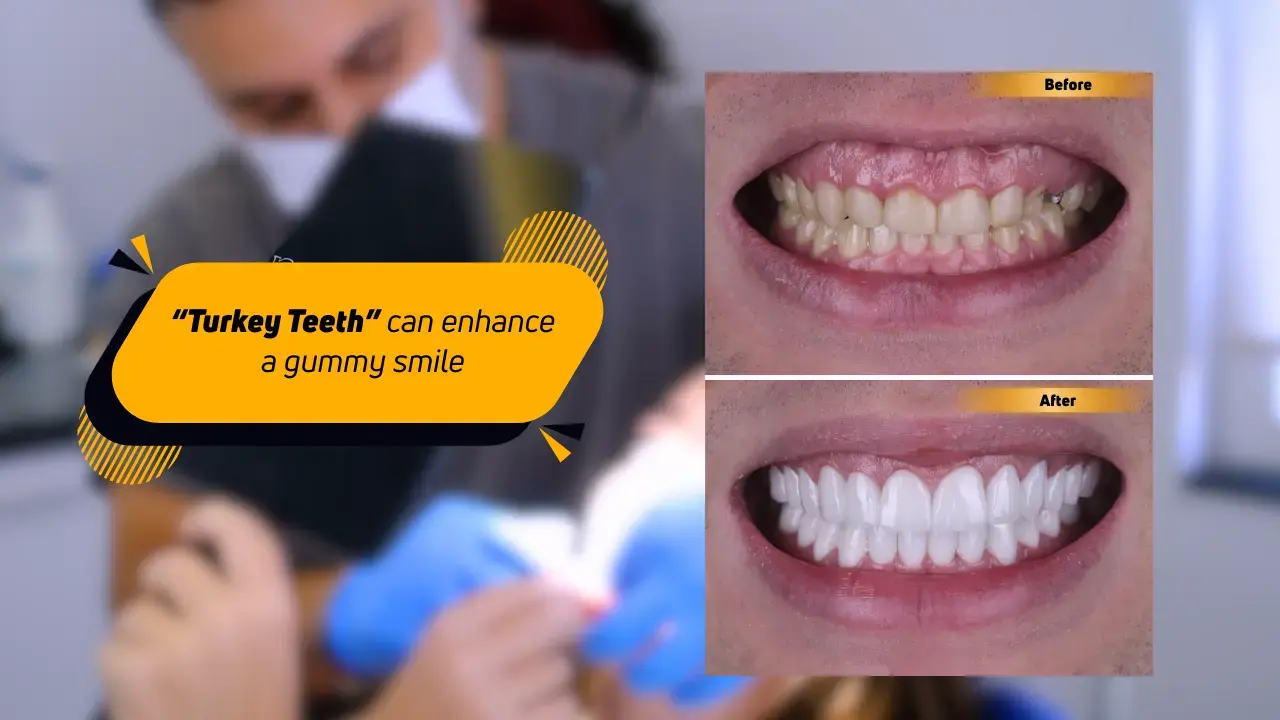
How can dental bridge treat gummy smile?
A dental bridge can treat a gummy smile by filling gaps left by missing teeth, which alters the appearance of the gum line and creates a more balanced smile. The overall structure and alignment of the teeth are restored through the placement of a dental bridge, which improves the aesthetics of the smile by reducing the visibility of the gums.
Anchoring artificial teeth (pontics) to the adjacent natural teeth or dental implants is how a dental bridge functions. The pontics cover the gaps where teeth are missing, resulting in a continuous and seamless appearance. It enhances the mouth's functionality by restoring the ability to chew and speak correctly and significantly enhances the smile's aesthetics. The gums are no longer the focal point, and the proportion of teeth to gums becomes more balanced as the spaces are filled with a dental bridge.
A dental bridge supports the adjacent teeth and prevents them from relocating into the empty spaces left by the absent teeth. A gummy smile is exacerbated by the misalignment and further exposure of the gums that result from teeth shifting. A dental bridge contributes to preserving the natural contour of the gums by ensuring that the remaining teeth are in the correct position, diminishing their prominence when beaming.
The bridge complements the natural gingival line. A natural-looking smile is achieved by skilled dental professionals who shape the pontics to merge seamlessly with the adjacent teeth and gums. The customisation reduces the gummy smile effect by minimising the appearance of the gums and directing attention to the teeth.





